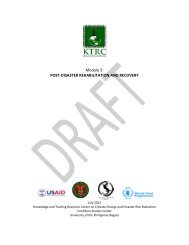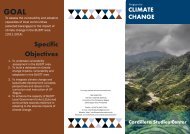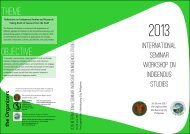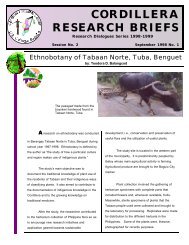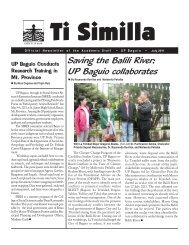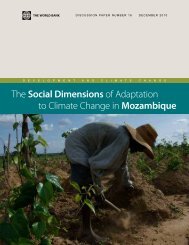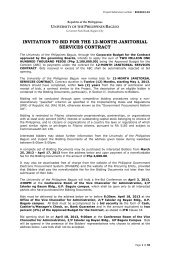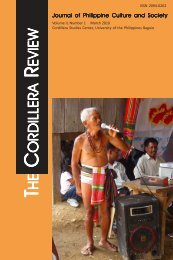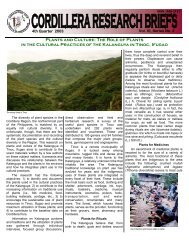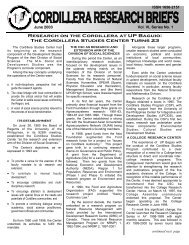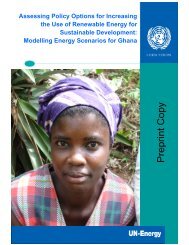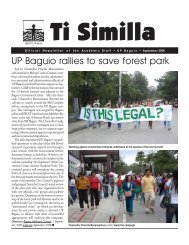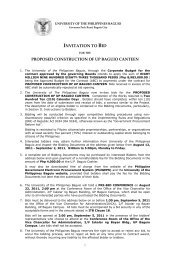Pambansang Summit sa W ambansang Summit sa W ... - UP Baguio
Pambansang Summit sa W ambansang Summit sa W ... - UP Baguio
Pambansang Summit sa W ambansang Summit sa W ... - UP Baguio
Create successful ePaper yourself
Turn your PDF publications into a flip-book with our unique Google optimized e-Paper software.
mg/m 3<br />
mg/m 3<br />
250<br />
200<br />
150<br />
100<br />
50<br />
0<br />
00:00<br />
02:00<br />
04:00<br />
06:00<br />
08:00<br />
10:00<br />
12:00<br />
14:00<br />
16:00<br />
18:00<br />
20:00<br />
22:00<br />
Source: EMB-DENR CAR 2011<br />
05:00 in the morning until 20:00 in the<br />
evening. The levels abate only when the<br />
residents are already in their homes, and<br />
may not neces<strong>sa</strong>rily be enjoying the benefits<br />
of the lower air pollution in the city<br />
center. Thus, on a daily basis, an ‘averaging<br />
out’ of the actual hourly pollution levels<br />
gives somehow a false sense of security,<br />
and masks the seriousness of the levels<br />
of exposure over the span of the day<br />
when the levels of pollution impact on<br />
them the most.<br />
How ‘acceptable’ or how ‘bad’ the air<br />
quality of <strong>Baguio</strong> really is? It now becomes<br />
obvious that the assessment depends on<br />
the standard that is being adopted as the<br />
norm. The more ‘lenient’ the standard<br />
being used, the ‘better’ the air quality appears<br />
to be. This means that there would<br />
be lesser political pressure on the local and<br />
national authorities to undertake measures<br />
to curb the current air pollution levels.<br />
When the health of the citizens is at risk<br />
through exposure to the current high concentrations<br />
of ambient air pollutants, the<br />
potential risk is not removed by adopting<br />
a more ‘permissive’ standard.<br />
An independent study on the air quality<br />
of <strong>Baguio</strong> by Cassidy, et al. (2007), using<br />
the levels of concentration of finer and<br />
even more dangerous particulates (PM 2.5 ),<br />
found a similar pattern of hourly concen-<br />
6 TI SIMILLA April 2011<br />
Philippines 24-hr<br />
Guideline<br />
67.3 <strong>Baguio</strong> 4-day<br />
mean<br />
WHO/EU 24-hr<br />
AQG<br />
Fig. 2. Hourly behavior of PM 10 levels in the <strong>Baguio</strong> Central Business<br />
District, 24-hr periods, 8-11 February 2011<br />
(In µg/m 3 )<br />
Column<br />
trations of the ambient air<br />
pollutant in the <strong>Baguio</strong><br />
CBD. The mean level over<br />
a three-week period in December<br />
2004 was determined<br />
to be at 72.9µg/m 3 .<br />
The guideline set by the<br />
WHO for PM 2.5 is 10µg/<br />
m 3 . For the US Environmental<br />
Protection Agency<br />
(EPA), standard is set at<br />
15µg/m 3 . For the EU, the<br />
standard is 25µg/m 3 . In<br />
general, the standards set<br />
for PM 2.5 are more stringent<br />
than those allowable<br />
for larger particulates. The<br />
authors used the figures they obtained to<br />
compare the <strong>Baguio</strong> PM 2.5 levels with<br />
those observed in selected cities of the<br />
world that had higher mean levels than<br />
the US EPA standard. The comparison is<br />
shown in Table 3.<br />
From their findings, the authors<br />
observed that:<br />
Excluding the studies in Beijing,<br />
China, no other study observed an average<br />
ambient PM 2.5 concentration as high<br />
as the levels present in <strong>Baguio</strong> City. …<br />
Continuous ambient concentrations of<br />
the magnitude seen in <strong>Baguio</strong> are rarely<br />
seen in developed countries and are sporadically<br />
seen within developing countries,<br />
except in areas prone to elevated concentrations<br />
partially<br />
due to local topography.<br />
The combination<br />
of pollution<br />
sources and the local<br />
topography makes<br />
<strong>Baguio</strong> City’s ambient<br />
air quality worse<br />
than that seen in<br />
most locations<br />
throughout the<br />
world.<br />
The evidence at<br />
hand on the levels of<br />
ambient air pollut-<br />
Sampling Location g/m 3<br />
Sampling Location g/m<br />
Beijing, China (1999-2000) 116.0<br />
Beijing, China (2003) 93.6<br />
<strong>Baguio</strong> City, Philippines (2004) 72.9<br />
Seoul, South Korea (2001-02) 48.5<br />
Turin, Italy (2000-01) 44.9<br />
Mexico City, Mexico (1997) 38.7<br />
Guatemala City, Guatemala (1997) 37.9<br />
Los Angeles - South Coast Basin (2002-04) 24.8<br />
Barcelona, Spain (2000-01) 22.2<br />
Paris, France (2000-01) 17.8<br />
3<br />
Beijing, China (1999-2000) 116.0<br />
Beijing, China (2003) 93.6<br />
<strong>Baguio</strong> City, Philippines (2004) 72.9<br />
Seoul, South Korea (2001-02) 48.5<br />
Turin, Italy (2000-01) 44.9<br />
Mexico City, Mexico (1997) 38.7<br />
Guatemala City, Guatemala (1997) 37.9<br />
Los Angeles - South Coast Basin (2002-04) 24.8<br />
Barcelona, Spain (2000-01) 22.2<br />
Paris, France (2000-01) 17.8<br />
Source: Cassidy, et al. 2007.<br />
ants in <strong>Baguio</strong>, set against the national and<br />
international minimum standards for a<br />
healthy air quality, point to an inescapable<br />
conclusion: the current air pollution<br />
levels in <strong>Baguio</strong>, on the basis of the mean<br />
levels of PM 10 and PM 2.5 , respectively, pose<br />
a potential risk to the health of local citizens.<br />
For this alone, there exists a societal<br />
problem at hand, and the issue merits foremost<br />
policy attention, recognition, and<br />
concerted policy design and intervention<br />
to bring down the levels of the known<br />
ambient air pollutants to the level of the<br />
national, if not international standards for<br />
public health.<br />
Will the Problem be Given Proper<br />
Recognition?<br />
What chances are there that the extent<br />
of the problem would indeed be recognized?<br />
Are there any complaints from the<br />
citizens of <strong>Baguio</strong>, and a clamor for measures<br />
to bring down current air pollution<br />
levels? A real cause for concern is that the<br />
finer ambient particulates are imperceptible<br />
to the man-on-the-street. When he/<br />
she suffers respiratory or coronary ailments<br />
from these air pollutants, the connection<br />
would not neces<strong>sa</strong>rily be established.<br />
For indeed, what proportion of the<br />
local residents would likely be informed<br />
of the nature of these ambient particulates,<br />
their levels of concentration in the air they<br />
continued on page 12<br />
Table 3. Mean PM concentrations in <strong>Baguio</strong> CBD and various cities in<br />
2.5<br />
the world.





